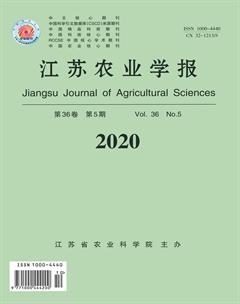生物炭與硝化抑制劑對菜地綜合溫室效應的影響
李佳 鄧鈞尹 周偉 孫麗英



摘要:采用靜態暗箱-氣相色譜法評估氮肥分別配施生物炭和硝化抑制劑對菜地生態系統綜合溫室效應(GWP)和溫室氣體排放強度(GHGI)的影響。共設置3個田間處理:尿素(U)、尿素配施生物炭(UB)和尿素配施硝化抑制劑雙氰胺(UDCD)。結果表明:與U處理相比,UDCD處理分別顯著降低了N2O排放通量和GWP的27.1%(P<0.05)和29.1%(P<0.05),而對CH4排放通量、蔬菜產量以及GHGI并沒有顯著影響。與U處理相比,UB處理對N2O排放通量、GWP和GHGI并無顯著影響。與UB處理相比,UDCD處理分別顯著降低了N2O排放通量和GWP的28.3%(P<0.05)和29.1%(P<0.05)。綜合對比3種施肥方式的GWP和GHGI,發現氮肥配施硝化抑制劑DCD可以顯著減少氮肥對環境的影響,因此在菜地可推薦使用尿素配施硝化抑制劑雙氰胺(UDCD)施肥方案。
關鍵字:生物炭;硝化抑制劑;CH4;N2O;菜地;綜合溫室效應
中圖分類號:S181文獻標識碼:A文章編號:1000-4440(2020)05-1205-07
Abstract:Static opaque chamber-gas chromatography method was used to study the effects of nitrogen fertilizer combined with biochar and nitrification inhibitor respectively, on the global warming potential (GWP) and greenhouse gas intensity (GHGI) of ecosystem in vegetable field. Three following field treatments were set up: urea (U), urea combined with biochar (UB) and urea combined with nitrification inhibitor dicyandiamide (UDCD). The results showed that compared with U treatment, UDCD treatment significantly decreased the N2O emission flux and GWP by 27.1% (P<0.05) and 29.1% (P<0.05) respectively, but there were no significant effects on CH4 emission flux, vegetable yield and GHGI. Compared with U treatment, UB treatment had no significant effects on N2O emission flux, GWP and GHGI. Compared with UB treatment, UDCD treatment significantly decreased N2O emission flux and GWP by 28.3% (P<0.05) and 29.1% (P<0.05), respectively. The nitrogen fertilizer combined with DCD is recommended for reducing the effect of nitrogen fertilizer on environment significantly by comprehensive comparison of GWP and GHGI under three fertilization modes. Therefore, the UDCD fertilizing scheme is recommend in vegetable field.
Key words:biochar;nitrification inhibitor;methane;nitrous oxide;vegetable field;global warming potential
蔬菜地是一種特殊的農業生態系統,與其他大田作物相比,蔬菜生產集約化程度高、復種指數高、氮肥用量遠超于推薦施肥量,導致氮肥利用率越來越低,N2O和CH4大量排放[1]。而N2O和CH4是兩種重要的農業源溫室氣體。據聯合國氣候變化政府間專家委員會(IPCC)報告,在過去的200年里,大氣N2O和CH4質量濃度分別由西方工業化之前的270.9 μg/L和0.73 mg/L,增加到2005年的325.1 μg/L和1.82 mg/L,預計今后仍將呈線性增長[2]。在100年時間尺度上,N2O和CH4的增溫潛勢分別是CO2的298和34倍。據Wang等估算,中國菜地施肥引起的直接N2O排放量為66.95 Gg N,約占中國農田總直接N2O排放量的21.4%[3]。因此,尋找切實可行的減排措施減緩菜地溫室氣體的排放具有重要的意義且十分迫切。
近年來,大量研究結果表明生物炭和硝化抑制劑對農業增產減排的效果顯著[4-5]。生物炭是指生物質在限氧條件下通過熱裂解方法制備而成的一種富含孔隙結構、含碳量高、碳穩定性強的一種非純凈碳的混合物。生物炭施入到土壤中能改善土壤質量,降低土壤溫室氣體排放,提高作物產量[6-7]。據Cayuela等報道,生物炭的施用可以平均降低54%的農業生態系統N2O的排放。因此,農田施用生物炭可以作為農業增產減排的一個新途徑[8]。硝化抑制劑能抑制土壤中的硝化作用,從而減少氮肥的損失,提高氮肥利用率而增加作物產量,同時能減緩溫室氣體的排放[9]。目前,國內外對蔬菜地溫室氣體排放的研究較多,通常認為添加生物炭與硝化抑制劑能減緩N2O的排放[10-12]。因此,生物炭和硝化抑制劑都是目前農業上廣泛使用的用來增加作物產量、固碳減排的有效措施。但是,同時對比研究生物炭與硝化抑制劑對菜地溫室效應的影響的研究較少。因此,本研究將探討氮肥分別配施生物炭和硝化抑制劑條件下菜地N2O、CH4的排放特征以及對蔬菜產量的影響。以期為菜地生態系統增產減排提供理論依據。
1材料與方法
1.1試驗設計
田間試驗于2018年6月在江蘇省南京市浦口區浦浩生態園(32°14′N,118°41′E)進行,該區域屬于典型的亞熱帶季風氣候。該地塊已有5年多的集約化蔬菜種植歷史。表層土壤(0~15 cm)的基本性質為:pH 6.5,總氮含量1.4 g/kg,土壤有機碳含量24.1 g/kg。試驗中所用的生物炭由水稻秸稈在550~650 ℃裂解而成,基本性質為:總碳含量462.2 g/kg,總氮含量7.2 g/kg,碳氮比64.2,pH 6.5,表面積11.5 m2/g。雙氰胺(DCD),作為一種硝化抑制劑,與氮肥混合施用能降低農田溫室氣體的排放并提高氮肥利用率,因此廣泛應用于農業生產中。
試驗共設置3個處理,每個處理3個重復。3個處理分別為僅施尿素(U)、尿素配施生物炭(UB)、尿素配施硝化抑制劑雙氰胺(UDCD)。所有處理中施肥水平一致,根據當地常規施肥水平確定,即氮肥(以N計)施入量為200 kg/hm2,磷肥(以P2O5計)施入量為200 kg /hm2,鉀肥(以K2O計)施入量為200 kg/hm2。生物炭的施用量為30 t/hm2。硝化抑制劑DCD按常規施氮量5%的比例與尿素混勻。在播種之前,將氮肥、磷肥、鉀肥和生物炭施入到土壤中,并翻耕使其混合均勻。試驗期間共種植一茬不結球白菜,于2018年6月10日播種,2018年7月21日收獲,蔬菜生長期間不追肥。在整個試驗期間,其他管理措施都按照當地常規進行。
1.2樣品采集與分析
采用靜態暗箱-氣相色譜法測定菜地土壤N2O和CH4的排放通量。采樣箱和采樣底座均由PVC材料制成,采樣箱長、寬、高分別為45 cm、45 cm、50 cm。在試驗開始之前,將方形的采樣箱底座安裝在各個小區中,采樣時,將采樣箱扣在采樣箱底座上,用水密封。采樣時間為上午8∶00-10∶00,扣上采樣箱之后,于0 min、10 min、20 min、30 min分別用20 ml的針筒收集4針氣體樣品,然后將樣品帶回實驗室,在12 h之內用氣相色譜儀(安捷倫7890 B)分析N2O和CH4濃度。采樣頻率一般為每7 d 1次,施肥之后每隔1 d收集1次樣品,持續7 d。氣相色譜儀測定樣品中N2O和CH4的檢測器分別為電子捕獲檢測器(ECD)和氫火焰離子化檢測器(FID)。
每次采集氣體樣品時,同時采集耕層土壤(0~15 cm)樣品,儲存于-4 ℃冰箱,用來測定土壤銨態氮(NH+4-N)、硝態氮(NO-3-N)含量。NH+4-N和NO-3-N含量分別采用靛酚藍比色法和雙波長紫外分光光度計法測定。蔬菜收獲之后,直接稱量新鮮的地上部分,獲得每個小區的蔬菜產量。
1.3數據處理與分析方法
N2O、CH4排放通量計算公式如下:F=ρ×V/A×dC/dt×273/(273+T)。式中,F為N2O-N或CH4-C排放通量,單位為μg/(m2·h)或mg/(m2·h);ρ為標準狀態下N2O-N和CH4-C的質量濃度,分別為1.25 g/L和0.54 g/L;V為采樣箱體積,m3;A為采樣箱底面積,m2;dC/dt為N2O或CH4的排放速率,單位為nl/(L·h)或μl/(L·h);T為采樣時箱內平均溫度,℃。用每個處理的3個重復的平均值表示N2O和CH4的排放通量。
利用菜地N2O和CH4的增溫潛勢之和來計算菜地的綜合溫室效應(GWP,t/hm2,以CO2計)。在100年時間尺度上,N2O和CH4的增溫潛勢分別是CO2的298和34倍[2],GWP(t/hm2)計算公式如下:GWP=298×GWP(N2O)+34×GWP(CH4)。溫室氣體排放強度(GHGI,t/t,以CO2計)是指單位產量的綜合溫室效應。計算公式如下:GHGI=GWP/產量,式中產量單位為t/hm2。
采用Microsoft Excel 2013和OriginPro 8.5軟件進行圖表制作。采用JMP 9.0軟件進行多重比較分析(Students)。采用Pearsons法分析無機態氮(NH+4-N和NO-3-N)與N2O和CH4排放通量之間的相關性。
2結果與分析
2.1生物炭與硝化抑制劑DCD對N2O排放的影響
由圖1可知,在整個蔬菜生長季,各處理的N2O排放通量的變化趨勢一致。所有處理都在施肥后第5 d出現N2O排放通量最大峰值,然后快速下降,之后各處理N2O排放通量均保持在較低水平。UB、U、UDCD處理的N2O排放通量的最大峰值由高到低分別為2 781.66 μg/(m2·h)、2 447.89 μg/(m2·h)、1 751.04 μg/(m2·h)。
整個蔬菜生長期,UB、U、UDCD處理的N2O累積排放量分別為4.64 kg/hm2、4.56 kg/hm2、3.33 kg/hm2(表1)。與U處理相比,UB處理增加了1.9%的N2O累積排放量(P>0.05),而UDCD處理顯著降低了27.0%的N2O累積排放量(P<0.05)。與UB處理相比,UDCD處理顯著降低了28.3%的N2O累積排放量(P<0.05)。
2.2生物炭與硝化抑制劑DCD對CH4排放的影響
由圖2可知,整個觀測期間,CH4的排放通量變化較平穩。UB處理在施肥第7 d出現CH4排放峰,峰值為0.14 μg/(m2·h),其他處理則無明顯CH4排放峰。而UB處理的CH4平均排放通量高于其他兩個處理。U、UDCD處理的CH4排放總量均為0.13 kg/hm2,而UB處理高達0.45 kg/hm2。UB處理的CH4排放通量高于U、UDCD處理CH4排放量,但無顯著差異(P>0.05)。
2.3菜地CH4排放與土壤NH+4-N、NO-3-N含量的相關性
參考文獻:
[1]紀夢夢,吳曉剛,吳欣欣,等. 過量施肥對設施菜田土壤菌群結構及N2O產生的影響[J]. 微生物學通報, 2018, 45(6): 1452-1459.
[2]Intergovernmental Panel on Climate Change (IPCC). Climate change 2013: the physical science basis[R]. Cambridge: Cambridge University Press, 2013.
[3]WANG J Y, XIONG Z Q, YAN X Y. Fertilizer-induced emission factors and background emissions of N2O from vegetable fields in China [J]. Atmospheric Environment, 2011, 45: 6923-6929.
[4]李博,李巧玲,范長華,等. 施用生物炭與硝化抑制劑對菜地綜合溫室效應的影響[J]. 應用生態學報, 2014, 25(9): 2651-2657.
[5]易瓊,逄玉萬,張木,等. 不同施肥模式下硝化抑制劑DCD與生物炭對菜地N2O排放和土壤特性的影響[J]. 生態環境學報, 2017, 26(8):1336-1341.
[6]ZHANG A F, CHENG G, QAISER H, et al. Contrasting effects of straw and straw-derived biochar application on net global warming potential in the Loess Plateau of China [J]. Field Crops Research, 2017, 205: 45-54.
[7]陳晨,許欣,畢智超,等.生物炭和有機肥對菜地土壤N2O排放及硝化、反硝化微生物功能基因豐度的影響[J]. 環境科學學報, 2017, 37(5): 1912-1920.
[8]CAYUELA M L, VAN ZWIETEN L, SINGH B P, et al. Biochars role in mitigating soil nitrous oxide emissions: a review and meta-analysis [J]. Agriculture Ecosystems and Environment, 2014, 191: 5-16.
[9]GUO Y J, DI H J, CAMERON K C, et al. Effect of 7-year application of a nitrification inhibitor, dicyandiamide (DCD), on soil microbial biomass, protease and deaminase activities, and the abundance of bacteria and archaea in pasture soils[J]. Journal of Soils and Sediments, 2013, 13(4): 753-759.
[10]DI T, ZHANG Y Y, ZHOU Y Z, et al. Effect of nitrification inhibitors on mitigating N2O and NO emissions from an agricultural field under drip fertigation in the North China Plain [J]. Science of the Total Environment, 2017, 598: 87-96.
[11]HUSSAIN M, FAROOQ M, NAWAZ A, et al. Biochar for crop production: potential benefits and risks [J]. Journal of Soils and Sediments, 2017, 17(3): 685-716.
[12]KONG X, ERIKSEN J, PETERSEN S. Evaluation of the nitrification inhibitor 3,4-dimethylpyrazole phosphate (DMPP) for mitigating soil N2O emissions after grassland cultivation [J]. Agriculture Ecosystems and Environment, 2018, 259: 174-183.
[13]MAUCIERI C, ZhANG Y, MCDANIEL M D, et al. Short-term effects of biochar and salinity on soil greenhouse gas emissions from a semi-arid Australian soil after re-wetting [J]. Geoderma, 2017, 307: 267-276.
[14]ZHANG A, CUI L, PAN G, et al. Effect of biochar amendment on yield and methane and nitrous oxide emissions from a rice Paddy from Tai Lake Plain, China [J]. Agriculture Ecosystems and Environment, 2010, 139: 469-475.
[15]CASE S D C, MCNAMARA N P, REAY D S, et al. Can biochar reduce soil greenhouse gas emissions from a Miscanthus bioenergy crop? [J]. GCB Bioenergy, 2014, 6: 76-89.
[16]熊舞,夏永秋,周偉,等. 菜地氮肥用量與N2O排放的關系及硝化抑制劑效果[J]. 土壤學報, 2013, 50(4):743-751.
[17]FRIEDL J, SCHEER C, ROWLINGS D W, et al. The nitrification inhibitor DMPP (3,4-dimethylpyrazole phosphate) reduces N2 emissions from intensively managed pastures in subtropical Australia [J]. Soil Biology Biochemistry, 2017, 108:55-64.
[18]ASING J, SAGGAR S, SINGH J, et al. Assessment of nitrogen losses from urea and an organic manure with and without nitrification inhibitor, dicyandiamide, applied to lettuce under glasshouse conditions [J]. Soil Research, 2008, 46(7): 535-541.
[19]KHAN S, WANG N, REID B J, et al. Reduced bioaccumulation of PAHs by Lactuca satuva L. grown in contaminated soil amended with sewage sludge and sewage sludge derived biochar [J]. Environmental Pollution, 2013, 175: 64-68.
[20]李露,周自強,潘曉健,等.氮肥與生物炭施用對稻麥輪作系統甲烷和氧化亞氮排放的影響[J].植物營養與肥料學報, 2015, 21(5): 1095-1103.
[21]WEISKE A, BENCKISER G, HERBERT T, et al. Influence of the nitrification inhibitor 3,4-dimethylpyrazole phosphate (DMPP) in comparison to dyciandiamide (DCD) on nitrous oxide, carbon dioxide fluxes and methane oxidation during 3 years of repeated application in field experiments [J]. Biology and Fertility of Soils, 2001, 34: 109-117.
[22]LI B, BI Z C, XIONG Z Q. Dynamic responses of nitrous oxide emission and nitrogen use efficiency to nitrogen and biochar amendment in an intensified vegetable field in southeastern China [J]. GCB Bioenergy,2016, 9: 400-413.
[23]ZHANG D, PAN G, WU G, et al. Biochar helps enhance maize productivity and reduce greenhouse gas emissions under balanced fertilization in a rainfed low fertility inceptisol [J]. Chemosphere, 2016, 142: 106-113.
[24]張洋,李雅穎,鄭寧國,等. 生物硝化抑制劑的抑制原理及其研究進展[J]. 江蘇農業科學,2019,47(1):21-26.
[25]FAN C, LI B, XIONG Z Q. Nitrification inhibitors mitigated reactive gaseous nitrogen intensity in intensive vegetable soils from China [J]. Science of the Total Environment, 2018, 612: 480-489.
[26]ABALOS D, JEFFRY S, SANZ-CORBINA A, et al. Meta-analysis of the effect of urease and nitrification inhibitors on crop productivity and nitrogen use efficiency [J]. Agriculture Ecosystems and Environment, 2014, 189:136-144.
(責任編輯:張震林)

